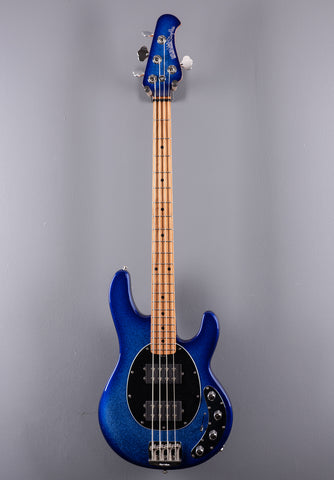Winds of Change
 We’ve seen a major shift in the music landscape in the last three years, largely due to the increased interest in learning or relearning an instrument. If there is anything positive to take away from an international pandemic, it might be the reinvigoration of the music community. The isolative nature of the pandemic gave people the opportunity to reignite musical passions that may have been put on the backburner. Simultaneously, a tidal wave of new musicians has emerged, but you may be surprised to learn that many are not gravitating towards the guitar.
We’ve seen a major shift in the music landscape in the last three years, largely due to the increased interest in learning or relearning an instrument. If there is anything positive to take away from an international pandemic, it might be the reinvigoration of the music community. The isolative nature of the pandemic gave people the opportunity to reignite musical passions that may have been put on the backburner. Simultaneously, a tidal wave of new musicians has emerged, but you may be surprised to learn that many are not gravitating towards the guitar.
Bucking tradition, new players don’t necessarily revere legendary guitar maestros of the past the way they used to. The contributions of legends like Jimmy Page are well documented and certainly still celebrated, but it seems this new swath of musicians are more interested in the John Paul Jones story. More and more, we’re seeing new musicians' muse come from a place of thunder. The harmonic and rhythmic foundation of so many great bands, and a long underrepresented instrument in the music zeitgeist; all hail the bass!
Before We Get Into It
This article may come off to some folks as an indictment of the guitar, but that is not at all what this is. Just so we are all on the same page, we’re still Dave’s Guitar Shop! The legendary “Mecca of the Midwest” for guitar players and collectors alike. We still love the six-string as much as we did 40 years ago, and that’s never going to change.
Think of this as a love letter to an instrument that, for a long time, has been perceived as the “easy version” of playing the guitar. Bass is as much a part of the guitar family as a Ukelele or Mandolin, and should be shown the same kind of reverence for its contribution to modern music. We intend to highlight why the bass is so great, why the bass has gained so much popularity, and where to start if you’re new to the bass. So, let’s get started!
Basses to Know
Good guitar players can control the eyes of a crowd through technical precision and phrasing, but when a bass player is laying a groove, they control the audience in a visceral way. Bass frequencies can be physically felt, and have the power to compel a crowd to move be it dancing, flailing, moshing, or toe tapping. A seasoned bassist knows what kind of grooves to put down, but they also know what gear to use to elevate their tone. For the uninitiated, here are some important bass guitars to be aware of.
 Fender Precision Bass
Fender Precision Bass
Leo Fender had a knack for getting things right on the first try. Fender introduced the Precision Bass, colloquially known as the “P-Bass'' in 1951. Born out of the necessity for bass frequencies to cut through a mix in big band settings, this model stands the test of time because of its ease of use. Just plug in, and you get a fat, punchy tone that almost immediately sounds good.
Fender Jazz Bass
Who would have thought Jazz musicians would make things more complicated (because of course they would.) The Jazz Bass was designed as a logical next step in Fender’s line of bass guitars. Jazz musicians were looking for a cleaner, more articulate sound from their basses. Additionally, Jazz Basses generally feature slimmer necks and narrower nut width than P-Basses, to accommodate the often complicated bass lines played by Jazz musicians. While their initial conception was with Jazz artists in mind, Jazz Basses have become synonymous with modern music, and is often the go-to for bass players far and wide.
complicated (because of course they would.) The Jazz Bass was designed as a logical next step in Fender’s line of bass guitars. Jazz musicians were looking for a cleaner, more articulate sound from their basses. Additionally, Jazz Basses generally feature slimmer necks and narrower nut width than P-Basses, to accommodate the often complicated bass lines played by Jazz musicians. While their initial conception was with Jazz artists in mind, Jazz Basses have become synonymous with modern music, and is often the go-to for bass players far and wide.
(Ernie Ball) MusicMan StingRay
 a non-musician himself, was in the early days of electric guitar and bass. After selling his namesake to CBS in 1965, Leo was approached by Forrest White and Tom Walker of Tri-Sonix, which would eventually become MusicMan. Leo, in his quest for innovation in the music world, helped develop the StingRay; the first production bass to feature active electronics. This allowed for bass players to have a mix-cutting, scooped tone that places the bass foreword in a mix. The StingRay became a favorite amongst funk
a non-musician himself, was in the early days of electric guitar and bass. After selling his namesake to CBS in 1965, Leo was approached by Forrest White and Tom Walker of Tri-Sonix, which would eventually become MusicMan. Leo, in his quest for innovation in the music world, helped develop the StingRay; the first production bass to feature active electronics. This allowed for bass players to have a mix-cutting, scooped tone that places the bass foreword in a mix. The StingRay became a favorite amongst funk
Rickenbacker 4001/4003
Höfner 500/1 “Beatle” Bass
Why is Bass so Popular Today?
Bass in Pop Music
Painting with a broad brush, a majority of the chart topping hits you hear on the radio are also songs you might hear at a dance club. Generally they’ll share a common element; bass! Earlier, we expressed that bass tones create a visceral response to the listener, often eliciting physical movement in the form of dance. It’s no wonder Pop music leans so heavily on bass to create feelgood songs in heavy rotation.
When the Disco movement made its debut in the discotheque and club scene of the 1970’s, it proved that drum and bass-driven music was here to stay. Groups like Chic, ABBA, and the Jackson 5 (to name a few) placed the bass guitar in the front of the mix, resulting in a trend that has persisted ever since. A modern example of this is Dua Lipa’s song Levitating, which spent 70 weeks in the Billboard Hot 100 chart. That song prominently features a disco inspired bass groove with its own built in melody.
Bass is not suddenly popular, its presence in pop culture has persisted for the last 50 years. It’s not that people suddenly started playing the bass, it’s that a majority of the music that we consume is bass-centric. While many artists lean on larger than life personalities to market their music, the bass is foundational to the sounds they’re selling.

Social Media
It used to be that everyone wanted to be a guitar player or lead singer, and that’s not by accident. When bands market themselves they often highlight an individual in that group (think Angus Young,) because it’s easier for the audience to relate to one person instead of a whole group. In the age of information, every musician is accessible! If you like the way the bass sounds on The Beautiful Game by Vulfpeck, a quick Instagram search allows you to follow and interact with Joe Dart. Today, your favorite artists are just a click away, and as a result, instruments like the bass are gaining more and more notoriety.
Secondly, while guitar is a staple of Rock and Roll’s history, our idea of “the guitar hero” isn’t the same as it was throughout the 60s, 70s, and 80s. The heroes of today aren’t legendary for playing sold out shows at Wembley Stadium, their audience is through the lens of a camera and distributed through phones and computer screens. Social media has brought fans closer to musicians’ personal lives than ever before, and created a meritocracy for what fans want to hear. Sure, guitar still dominates the digital landscape, but internet personalities like Davie504, Charles Berthoud, and juliaplaysgroove have created a platform for bass to flourish as more than it ever has.
Additionally, while it isn’t unique to the bass, every musician has a voice online. If you have a song that the world needs to hear, with the right recording equipment, creativity, and drive you too can take part in the cultural exchange of musical ideas. It doesn’t take much to find an unknown musician's rendition or cover of a popular song, or an original piece of music. There are so many creative voices in the world, and for the first time in human history, you could potentially hear them all!
Bassists you Should Know
Now you might be inspired to dip your toes in the world of bass, but maybe you don’t know where to start. That’s okay, Dave’s Guitar Shop has got you covered! We’ve compiled a short list of bass players that you should check out, the projects they’re a part of, and the type of bass they use.
If you're thinking about buying a bass, questions about gear, or just want to talk shop; give us a shout at any one of our four locations. We'd be happy to help in any way we can!



The Reggie Hamilton Fender I bought at Dave’s is my go to when I play in a rock/pop/country quartet and in a duo for Bob Dylan/Mark Knopfler genre. I switched the round wound strings out for flat wound, and had it converted to fretless. Excellent sound. Use an upright electric and bass banjo for trad Jazz/swing/riverboat banjo groups.
Started playing bass in 1954 and now, optimistically, have been eyeing Fender’s Suona Jazz Thinline, but may have to practically fit a new Laptop into the budget first.
I agree with Randy (see above). The only “power duo” I can think of is the “White Stripes”. Where would Cream be without Jack Bruce or Jimi Hendrix without Noel Redding? , etc. I am a working guitar player by trade, however I still have a few basses ready for fill-ins.
Awesome article! As a bassist for over 50 yrs. I’ve witnessed the 50’s 60’s 70’s and the present landscape of popular music. We used to have a saying… “plenty of unemployed guitarists… but if you’re a good bass player, you are working!” (I live in Nashville)
Bass is the lifeblood of all music… imagine hearing a band without a bass… where would the feel, vibe, movement of the song be? Why does the band sound so… empty, 2-dimensional? Add bass.. BAM the power and magic of music is complete. Bass is the backbone of the sound of music!
Anyway… thanks for the good read!
Leave a comment